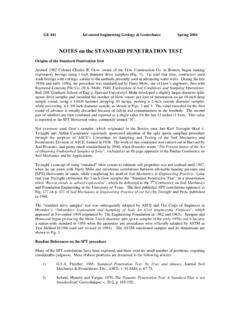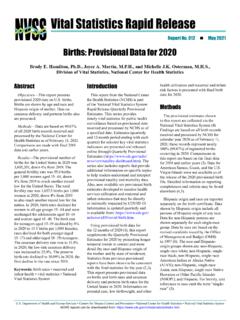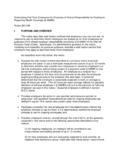Transcription of Analyzing Differences in Bacterial Optical Density ...
1 Analyzing Differences in Bacterial Optical Density Measurements between SpectrophotometersBrian C. Matlock1, Richard W. Beringer1, David L. Ash1, Michael W. Allen2 and Andrew F. Page11 ThermoFisher Scientific, UV-Vis/Fluor-Molecular Spectroscopy, Wilmington, DE. 2 ThermoFisher Scientific, UV-Vis/Fluor-Molecular Spectroscopy, Madison, Density (OD) measurement of Bacterial cultures is a common technique used in microbiology. Researchers have primarily relied on spectrophotometers to make these measurements, however the measurement is actually based on the amount of light scattered by the culture rather than the amount of light absorbed.
2 In their standard configuration, spectrophotometers are not optimized for light scattering measurements; commonly resulting in Differences in measured absorbance between study investigated the effect of different spectrophotometer Optical configurations on OD measurements of E. coli JM109 grown in batch culture. Spectrophotometers tested included reverse- Optical systems utilizing array detection, traditional monochromator-based systems, and a monochromator-based system with an integrating sphere accessory (ISA). Growth curves were measured on each instrument by determining the Optical Density at 600 nm (OD600) and by counting CFU/mL.
3 OD of McFarland standards was also measured in order to further characterize each Optical data from spectrophotometers in the same Optical configuration class were comparable. There was more variability between measurements at higher OD with the reverse Optical systems, caused by lower stray light performance of these instruments. Monochromator-based systems produced superior precision at higher OD primarily due to better stray light rejection of the monochromatic versus polychromatic light from reverse Optical systems.
4 However, the reverse Optical systems had a comparable dynamic range with respect to OD measurements. Use of an ISA resulted in data dissimilar from that produced with other systems because of its ability to capture nearly all of the forward scattered light. Measurement of McFarland standards confirmed these ability of a spectrophotometer to make reliable light scattering measurements is highly dependent on its Optical configuration; thus, spectrophotometers with different Optical configurations show different OD measurements.
5 Ideally, absorbance of highly scattering samples such as cell cultures is measured using an ISA in order to capture nearly all of the scattered light. Culture growth may be determined using OD600, however whenever changing spectrophotometers, a conversion factor should be calculated and applied. IntroductionThe standard phases of Bacterial culture growth (lag, log, stationary, and death) are well documented, with the log phase recognized as the point where bacteria divide as rapidly as possible(1). Using a spectrophotometer to measure the Optical Density at 600 nm (OD600) of a Bacterial culture to monitor Bacterial growth has always been a central technique in microbiology.
6 Three of the more common applications where Bacterial OD600 is used are the following: (a) determination and standardization of the optimal time to induce a culture during Bacterial protein expression protocols, (b) determination and standardization of the inoculum concentration for minimum inhibitory concentration (MIC) experiments, and (c) determination of the optimal time at which to harvest and prepare competent cells. Researchers continue to rely on absorbance spectrophotometers to make these OD measurements. Optical Density , however, is not a measure of absorbance, but rather a measure of the light scattered by the Bacterial suspension which manifests itself as absorbance (Figure 1).
7 The effect that the Optical configuration of a spectrophotometer has on Optical Density measurements has been well documented (2-4). Instruments with different Optical configurations will measure different Optical densities for the same Bacterial suspension. Differences in the Optical configuration of the spectrophotometer make the largest contribution to the observed Differences . Forward Optical systems employ monochromatic light for the measurement of absorbance where reverse Optical systems utilize polychromatic radiation that is discriminated into individual wave-lengths after it is passed through the sample (Figure 2).
8 Some components of the forward Optical systems contribute to a difference in measured OD values: (a) the distance between sample and detector, (b) the size and focal length of any collector lens used, and (c) the area and sensitivity of the detector (5). Despite current knowledge that different Optical configurations will give different OD values, researchers continue to raise concerns about the Differences in OD values seen among different spectrophotometers. In this study, we analyzed OD values obtained from several spectrophotometers possessing various Optical configurations.
9 We grew E. coli JM109 in batch culture and monitored the OD of the culture for hours. We demonstrate the need to dilute cultures before measurement and show how to apply a conversion factor to the OD data in order to normalize Differences in OD values due to the Optical geometries found in different of Thermo Fisher ScientificMaterials and Methods: Strain: E. coli JM109-endA1, recA1, gyrA96, thi, hsdR17 (rk , mk+), relA1, supE44, (lac-proAB), [F traD36, proAB, laqIqZ M15] (Promega, L2001)Spectrophotometers: Thermo Scientific spectrophotometers used are described in Table Curve: A 50 mL overnight E.
10 Coli JM109 culture was grown in a 250 mL baffled flask (16 hr, 250 rpm, 37 C) in Luria Bertani (LB) Broth. A batch culture was prepared by transferring 12 mL of the overnight culture in 600 mL of pre-warmed (37 C) LB media in a 2L baffled flask. The batch culture was grown for a total of hours. Culture Sampling: All spectrophotometers were blanked using LB broth. Every 30 minutes, a 5 mL aliquot was sampled from the batch culture. A 3 mL aliquot of undiluted culture was trans-ferred to a 10 mm cuvette, and the Optical Density at 600nm was measured on all the instruments listed above in Table 1.













